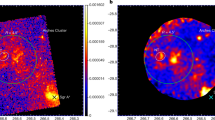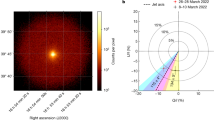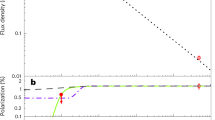Abstract
The nature of the jets and the role of magnetic fields in gamma-ray bursts (GRBs) remains unclear1,2. In a baryon-dominated jet only weak, tangled fields generated in situ through shocks would be present3. In an alternative model, jets are threaded with large-scale magnetic fields that originate at the central engine and that accelerate and collimate the material4. To distinguish between the models the degree of polarization in early-time emission must be measured; however, previous claims of gamma-ray polarization have been controversial5,6,7,8. Here we report that the early optical emission from GRB 090102 was polarized at 10 ± 1 per cent, indicating the presence of large-scale fields originating in the expanding fireball. If the degree of polarization and its position angle were variable on timescales shorter than our 60-second exposure, then the peak polarization may have been larger than ten per cent.
This is a preview of subscription content, access via your institution
Access options
Subscribe to this journal
Receive 51 print issues and online access
$199.00 per year
only $3.90 per issue
Buy this article
- Purchase on Springer Link
- Instant access to full article PDF
Prices may be subject to local taxes which are calculated during checkout




Similar content being viewed by others
References
Lyutikov, M. The electromagnetic model of gamma ray bursts. N. J. Phys. 8, 119–143 (2006)
Zhang, B. & Mészáros, P. Gamma-ray bursts: progress, problems and prospects. Int. J. Mod. Phys. A 19, 2385–2471 (2004)
Piran, T. Gamma ray bursts and the fireball model. Phys. Rep. 314, 575–667 (1999)
Lyutikov, M. Magnetocentrifugal launching of jets from discs around Kerr black holes. Mon. Not. R. Astron. Soc. 396, 1545–1552 (2009)
Coburn, W. & Boggs, S. E. Polarization of the prompt γ-ray emission from the γ-ray burst of 6 December 2002. Nature 423, 415–417 (2003)
Rutledge, R. E. & Fox, D. B. Re-analysis of polarization in the γ-ray flux of GRB 021206. Mon. Not. R. Astron. Soc. 350, 1288–1300 (2004)
Willis, D. R. et al. Evidence of polarisation in the prompt gamma-ray emission from GRB 930131 and GRB 960924. Astron. Astrophys. 439, 245–253 (2005)
McGlynn, S. et al. Polarisation studies of the prompt gamma-ray emission from GRB 041219a using the spectrometer aboard INTEGRAL. Astron. Astrophys. 466, 895–904 (2007)
Zhang, B., Kobayashi, S. & Mészáros, P. Gamma-ray burst early optical afterglows: implications for the initial Lorentz factor and the central engine. Astrophys. J. 595, 950–954 (2003)
Zhang, B. & Kobayashi, S. Gamma-ray burst early afterglows: reverse shock emission from arbitrarily magnetized ejecta. Astrophys. J. 628, 315–334 (2005)
Steele, I. A. et al. RINGO: a novel ring polarimeter for rapid GRB followup. Proc. SPIE 6269, 179S (2006)
Steele, I. A. et al. performance and first results. Proc. SPIE 5489, 679–692 (2004)
Mundell, C. G. et al. Early optical polarization of a gamma ray burst afterglow. Science 315, 1822–1824 (2007)
Mangano, V. et al. Swift observations of GRB 090102. GCN Rep. 192.1, (2009)
Klotz, A. et al. GRB 090102: TAROT Calern Observatory optical observations. GCN Circ. 8761, (2009)
Covino, S. et al. GRB 090102: REM observations of a bright afterglow. GCN Circ. 8763, (2009)
Gendre, B. et al. Testing the GRB models with the strange afterglow of GRB090102. Mon. Not. R. Astron. Soc. (submitted)
Gomboc, A. et al. Multiwavelength analysis of the intriguing GRB 061126: the reverse shock scenario and magnetization. Astrophys. J. 660, 489–495 (2008)
Gruzinov, A. & Waxman, E. Gamma-ray burst afterglow: polarization and analytical light curves. Astrophys. J. 511, 852–861 (1999)
Gruzinov, A. Strongly polarized optical afterglows of gamma-ray bursts. Astrophys. J. 525, L29–L31 (1999)
Medvedev, M. V. & Loeb, A. Generation of magnetic fields in the relativistic shock of gamma-ray burst sources. Astrophys. J. 526, 697–706 (1999)
Covino, S. et al. GRB 990510: linearly polarized radiation from a fireball. Astron. Astrophys. 348, L1–L4 (1999)
Wijers, R. A. M. et al. Detection of polarization in the afterglow of GRB 990510 with the ESO Very Large Telescope. Astrophys. J. 523, L33–L36 (1999)
Lazzati, D., Rossi, E., Ghisellini, G. & Rees, M. J. Compton drag as a mechanism for very high linear polarization in gamma-ray bursts. Mon. Not. R. Astron. Soc. 347, L1–L5 (2004)
Mimica, P., Giannios, D. & Aloy, M. A. Deceleration of arbitrarily magnetized GRB ejecta: the complete evolution. Astron. Astrophys. 494, 879–890 (2009)
Fan, Y. Interpretation and implications of the non-detection of GeV spectrum excess by the Fermi Gamma-ray Space Telescope in most gamma-ray bursts. Mon. Not. R. Astron. Soc. 397, 1539–1548 (2009)
Granot, J. The most probable cause for the high gamma-ray polarization in GRB 021206. Astrophys. J. 596, L17–L21 (2003)
Götz, D., Laurent, P., Lebrun, F., Daigne, F. & Bošnjak, Ž. Variable polarization measured in the prompt emission of GRB 041219A using IBIS on board INTEGRAL. Astrophys. J. 695, L208–L212 (2009)
Schmidt, G. D., Elston, R. & Lupie, O. L. The Hubble Space Telescope northern-hemisphere grid of stellar polarimetric standards. Astron. J. 104, 1563–1567 (1992)
Clarke, D. & Neumayer, D. Experiments with a novel CCD stellar polarimeter. Astron. Astrophys. 383, 360–366 (2002)
Acknowledgements
The Liverpool Telescope is operated on the island of La Palma by Liverpool John Moores University in the Spanish Observatorio del Roque de los Muchachos of the Instituto de Astrofisica de Canarias with financial support from the UK Science and Technology Facilities Council. C.G.M. acknowledges financial support from the Royal Society and Research Councils UK. We thank J. Marchant for preparing Fig. 4 for us.
Author Contributions I.A.S. designed and built the instrument, and did data reduction and analysis. C.G.M. developed the initial scientific justification for the instrument and interpreted results. R.J.S. did data reduction and analysis. S.K. did theoretical interpretation of results. C.G. coordinated observations and identified the afterglow.
Author information
Authors and Affiliations
Corresponding author
Rights and permissions
About this article
Cite this article
Steele, I., Mundell, C., Smith, R. et al. Ten per cent polarized optical emission from GRB 090102. Nature 462, 767–769 (2009). https://doi.org/10.1038/nature08590
Received:
Accepted:
Issue Date:
DOI: https://doi.org/10.1038/nature08590
This article is cited by
-
A deep study of the high–energy transient sky
Experimental Astronomy (2021)
-
Synchrotron radiation in γ-ray bursts prompt emission
Nature Astronomy (2020)
-
A robotic pipeline for fast GRB followup with the Las Cumbrés observatory network
Experimental Astronomy (2019)
-
Significant and variable linear polarization during the prompt optical flash of GRB 160625B
Nature (2017)
-
Gamma-Ray Bursts as Sources of Strong Magnetic Fields
Space Science Reviews (2015)
Comments
By submitting a comment you agree to abide by our Terms and Community Guidelines. If you find something abusive or that does not comply with our terms or guidelines please flag it as inappropriate.



